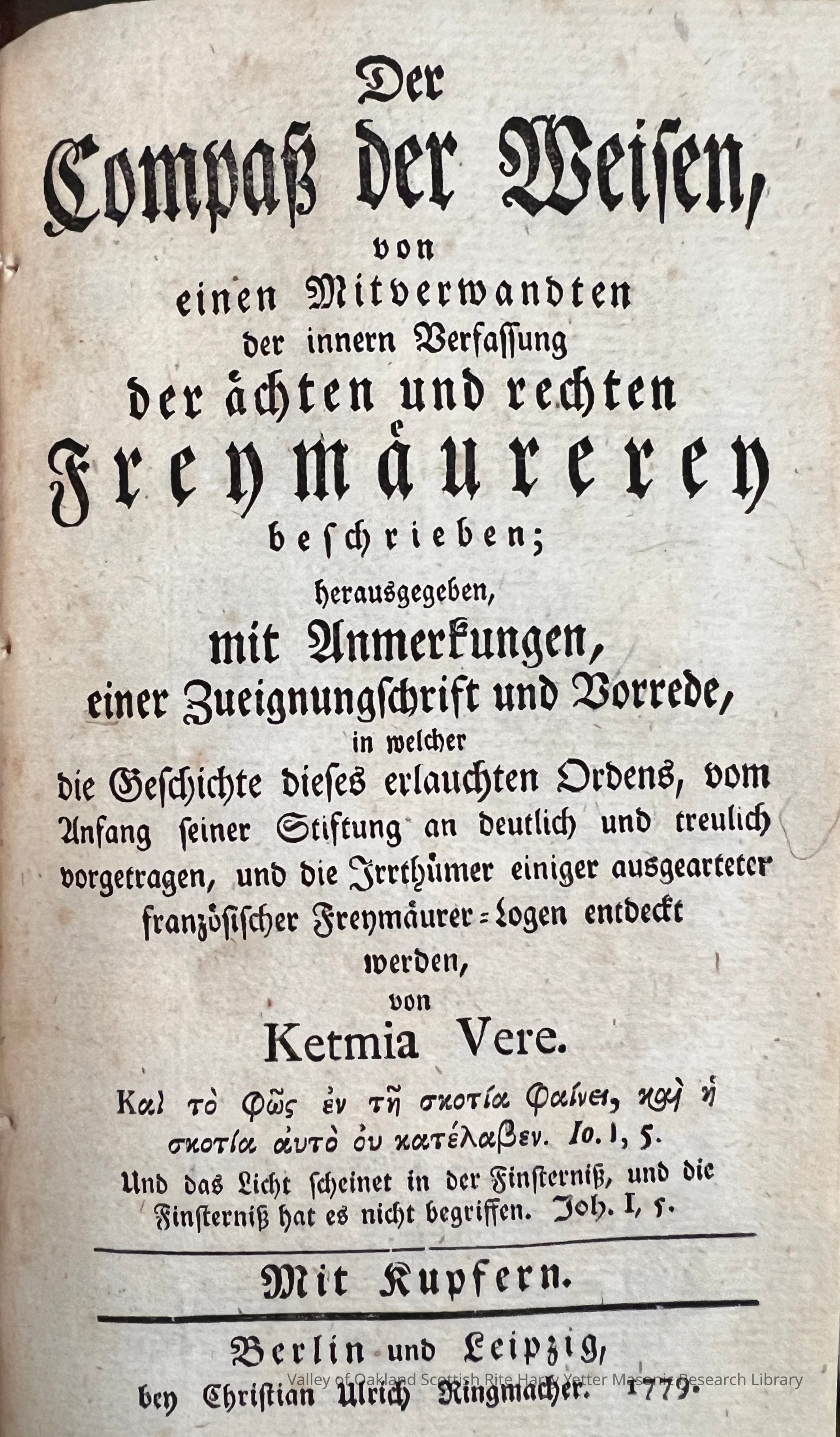Der Compaß der Weisen von einen Mitverwandten... & Die Offenbarte Freimaurerei und das entdeckte Geheimniß der Mopse
Name/Title
Der Compaß der Weisen von einen Mitverwandten... & Die Offenbarte Freimaurerei und das entdeckte Geheimniß der MopseEntry/Object ID
M19.55 V47oDescription
Two books bound together, with the frontispiece for Der Compaß misplaced with the title page for Die OffenbarteContext
This volume is curious for several reasons. First, it was found that this book is actually composed of two, rebound into a single at an unknown date. During a meeting with Dr. Andreas Önnerfors, a visiting scholar from Sweden, it was theorized that this may have occurred in the middle-to-late 18th century. Secondly, the frontispiece clearly belongs to the second book, Der Compaß der Weisen, and not Die Offenbarte der Freymaurei, and was placed incorrectly–either by design or by error; the reason is unknown. The other reasons concern the books’ contents, and for the important fact that the book was collected by Charles Gillette, a founding member of the Oakland Scottish Rite. This is the information Dr. Önnerfors and I were able to uncover: The first book, published by “Bruder Phidias” in Leipzig, Germany in 1745 is, Die Offenbarte der Freymaurerey und das Endeckte Geheimniß der Mopse (The Revelation of Freemasonry and the Discovered Secrets of the Pugs) [Figures 1 and 2] is one of the first translations into German from the French. It is a Masonic exposé containing various foldouts. The most interesting facet of the work is its revelations into the L’ordre des Mopses (Mops-Orden; Order of the Pug[s]), which was a co-ed Catholic organization popular amongst social elites and founded in Vienna c. 1738. Imitative of Freemasonry, it was designed to provide a fraternal environment for Catholics following the ban on Freemasonry by Pope Clement XII in 1738.1 The order, of which its central symbol was the faithful and loving pug dog (Fr.: carlin), enjoyed a short popularity in Germany, France, and the Netherlands. The second book is, from my perspective, the most exciting and interesting. It is Der Compaß der Weisen; von einen Mitverwandten der innern Verfassung der aechten und rechten Freymaeurerey beschrieben... (The Compass of the Wise; described by a relative of the inner constitution of the true and right Freemasonry...), published in Berlin and Leipzig, 1779 by Ketmia Vere. “Ketmia Vere” was the pseudonym of Adam Michael Birkholz (1746–1818). According to his entry on the website, “Hermetic Library,” Birkholz studied with Adam Friedrich von Seinsheim and Christan Knorr von Rosenroth “in the Minores (5th) grade of the Order of the Golden and Rosy Cross (Orden der Goldund Rosenkreutzer).” According to bibliographic sources, Birkholz’s book concerns exposing the errors of mainstream Freemasonry, and, as his title suggests, offers an insight into a more authentic version. In the dedication, Birkholz (writing as Vere) is very sympathetic to what he describes as an outlawed Orden der Gold- und Rosenkreutzer, which was a seminal early 18th century Rosicrucian–alchemical organization. By the mid-18th century, the order claimed to have invented Freemasonry, or at the very least, possessed the true meaning behind the latter organization’s symbols. Hence the boast in the book’s title about revealing the “true and right Freemasonry.” The book’s introduction states: “To all in the beloved fatherland of the German nation, persevering masters of wisdom, sage masters, persevering masters of wisdom, sons of wisdom, and outlaw fellow relatives of the most prized ancient order of the verified [authentic] Gold and Rosicrucians; dedicates this work, which is highly valuable because of its thoroughness, clarity and clarity, as a sign of his lifelong, most guilty gratitude, also to brotherly loyalty, love, and work, as a true Brother of the Rosy Cross.” The artwork, found at the start of the volume adjacent to the title page of first book, Die Offenbarte der Freymaurerey, gives a misleading impression that it was intended as a frontispiece for that book. However, it was most certainly once part of Der Compaß der Weisen, and was engraved by Hajonagogenus Nugir, who also engraved a small illustration for one of the book’s chapters. In 1779, Nu engraved twelve other Rosicrucian–alchemical plates for Hans Karl von Ecker‘s Freymäurerische Versammlungsreden der Gold- und Rosenkreutzer des alten Systems (Masonic assembly speeches of the Gold and Rosicrucians of the ancient Systems), 1779.Collection
German Masonic and Chivalric books, Gillett, Charles E., Special CollectionsCataloged By
Adam KendallCategory
Fraudulent Manuals and Rituals, Other





